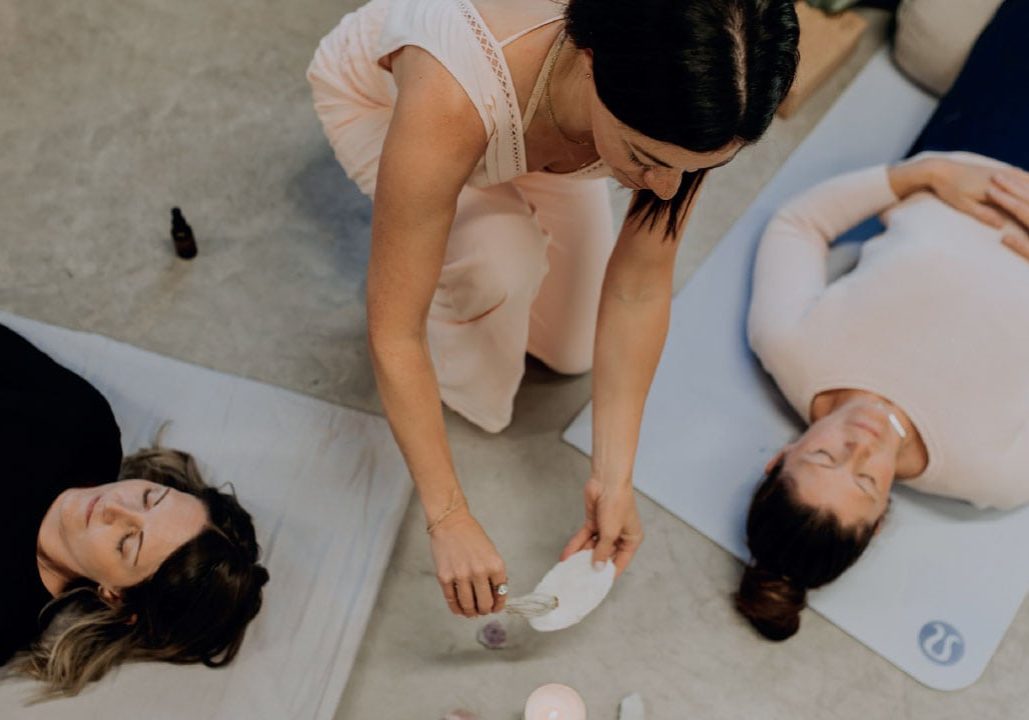
Permission to Rest
Savasana is more than a cool down, it’s an opportunity to choose rest. By Emma Gwillim
Reading time: 4 minutes
“I’ll just sneak out before Savasana, okay?” I’ve been guilty of it myself in the past, of skipping the rest pose at the end of an online class so that I could get on with my day. Lying for 10 minutes can feel like an indulgence or, dare I say it, a waste of time when you have a mental list as long as your arm to tackle.
What drew you to practice yoga in the first place? The most common motivations are to improve flexibility or strength, or to lower stress levels. Rarely making the list is the need to lie still and simply rest. In a culture built around productivity, maybe even our yoga practice has a desired output — an external goal of longer, leaner muscles, or improved sleep, or mastering a pose.
What makes Savasana a sacred time is that it offers permission to rest in a culture that values productivity and output.
Exhaustion is normalised. We suppress hunger and skip lunch. We push on with compulsive busy-ness until we meet burnout. The intelligence of the body — its cues to eat, to sleep, to rest — are overridden. Chronically stressed, the body becomes used to this survival energy of cortisol and adrenaline, a dominance of the sympathetic nervous system.
Through the lens of the gunas — the yoga wisdom that sees all material nature (prakritit) made up of three building blocks — this state of perpetual activity would be seen as the guna of rajas. We need rajas to get us out of bed in the morning. It’s associated with activity, heat, motivation, ambition and courage. It also has ‘reducing’ qualities such as anger, aggression, restlessness and attachment.
Tamas is its opposing quality of stability and inactivity, a state useful when we move to rest and sleep. It is also heavy, lethargic, apathetic and dark. As in nature, these gunas are constantly changing and flowing but when tamas becomes dominant, this can look like burnout or shutdown — a depletion and helplessness.
Sattva is the guna of balance, of wellbeing. It is contentment, light and openness, it has a sense of creativity as well as peace. Sattva is harmony.
Yoga offers tools to tend to our nature, to move into the harmony of sattva but, like any tool, it’s only valuable if we use it.
“What makes Savasana a sacred time is that it offers permission to rest in a culture that values productivity and output. Exhaustion is normalised.”
Making time to practice yoga asana, as an active, dynamic movement with an end goal, but skipping Savasana, exacerbates the tendency towards rajas. Our yoga practice becomes productive rather than harmonising.
Maybe this is why Savasana, a pose of rest and letting go, is seen as the most challenging pose of all. From a place of rajasic dominance, where busy-ness is the default, Savasana can feel so unfamiliar it feels unsafe
Rest is only available when the body feels safe to shift out of survival mode. It offers benefits to mind and body — known to reduce stress levels, improve mood and shift your body into a place of repair and recovery — but it’s not a one size fits all activity.
In her book Sacred Rest, Saundra Dalton-Smith identifies seven different types of rest: physical, mental, sensory, emotional, social, creative and spiritual. Yoga can meet many of these needs for rest: from the obvious physical rest that comes from mindful movement, the mental rest that comes with focus on a balancing pose, or meditation or pranayama practice, to the more subtle spiritual rest that can come from a sense of belonging and meaning.
Finding moments of active rest — without needing to earn it first, without feeling guilty and unproductive, and whether on the mat or off — begins to build the muscle of rest. It facilitates a natural flow between states, from the rajasic ‘doing’ to the tamasic ‘non-doing’, moving to the wellbeing state of sattva. This practices flexibility in the nervous system, moving from activation into safety and stillness, key to its resilience. Even in the rest pose of Savasana, while the body is still, the mind is alert, flowing between rajas and tamas.
Savasana is an invitation. Give yourself permission to choose rest and reveal your sattva.
Emma Gwillim is a trauma-informed yoga teacher, breathwork facilitator and freelance writer. You can find out more at emmagwillim.uk or connect on Instagram @emmagwillim




